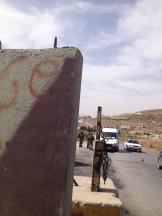Dura-Al Fawwar Junction, Hebron, Sansana (Meitar Crossing), South Hebron Hills
The illusion of quiet.
Everything appears normal along the road. The Meitar checkpoint is calm. The balloon floats in the same location.
Many soldiers at Dura-al-Fawwar junction in addition to those who came down from the pillbox. All stand ready on the road to al-Fawwar. Many children throwing rocks in a distant field. A polite captain approaches and starts talking, for some reason, in English. He remains polite when I reply in Hebrew. He says the children came to the road and threw rocks at passing cars. He said an older Palestinian came and told the children to return to the village (actually, a refugee camp), and they did.
Nevertheless, the soldiers established a flying checkpoint and began stopping cars. When I asked the commander why, everything’s over, his smile froze and he asked: “May I help you” and walked away. We waited a few minutes more and drove on. No one was there when we returned.

In Hebron, as happens sometimes, an illusion of quiet. Everything’s quiet and normal. Tomorrow the long summer vacation begins there, until September.
No detainees at the checkpoints and roadblocks, and no unusual incidents. Only on the road up to Tel Rumeida are cranes, cars and many soldiers. The Civil Administration
at the checkpoints and roadblocks, and no unusual incidents. Only on the road up to Tel Rumeida are cranes, cars and many soldiers. The Civil Administration and the Hebron Municipality are laying a sewer line for the residents’ benefit. Then the road will be repaved.
and the Hebron Municipality are laying a sewer line for the residents’ benefit. Then the road will be repaved.
We went to visit Abu wAnan on whose stolen land stood the Hazon David synagogue for a very long time, directly below Itamar Ben Gvir’s house. After a long legal battle the Supreme Court ordered it demolished. And it also voided the Kiryat Arba municipality’s Kafkaesque demand that Abu Anan pay them city taxes. NIS 88,000 for the building the settlers erected.

When we passed the rubble of the building we saw chairs, tables and a cabinet filled with prayer books. Yes, says Abu Anan, since the holiday they come twice a day to pray. The matter is again in court, because they’ll probably try to re-erect the tent.
He also say that every afternoon between 15:00-16:00 settlers living above him in the neighborhood they call Giv’at Ha’avot throw rocks. The area is called Wadi Hussein, and also named after the large hamula of Harath al Ja’aberi. He had two dunums of chickpeas adjoining the illegal structure and the settlers simply crushed it underfoot.
We’ll have to come in the afternoon to see what’s going on there.
